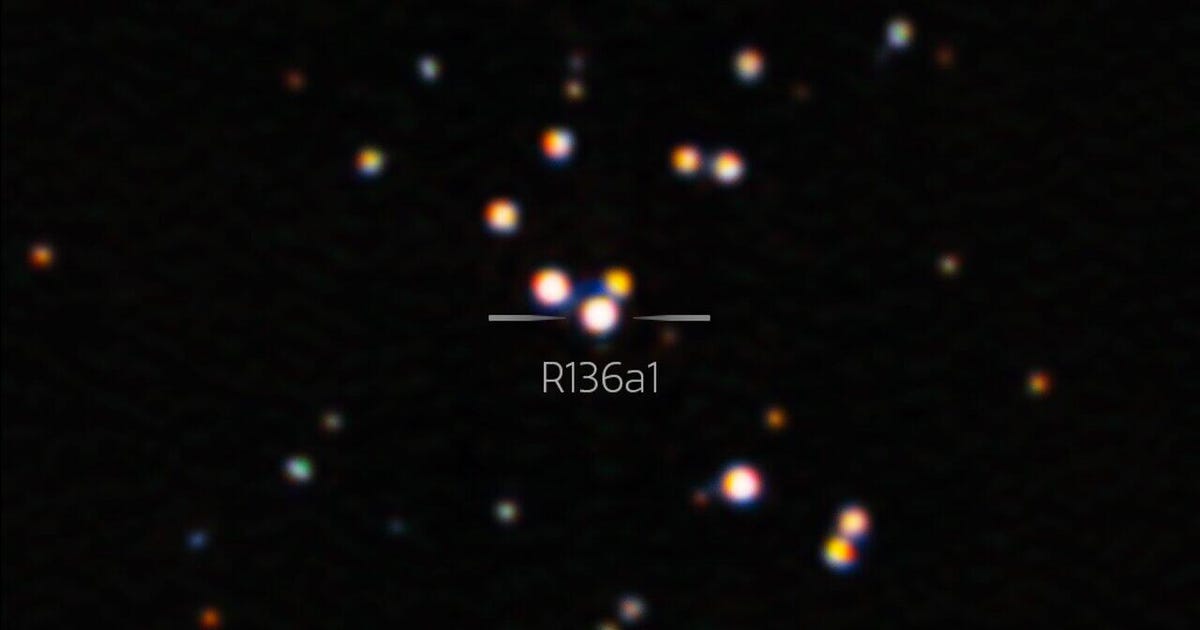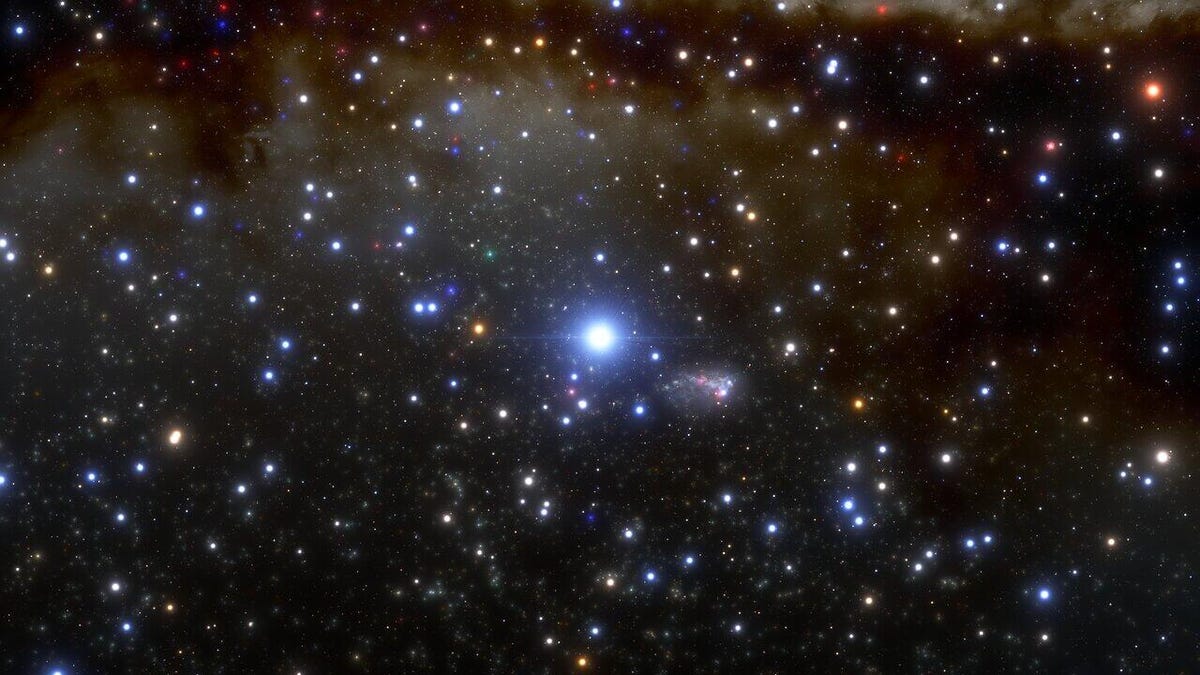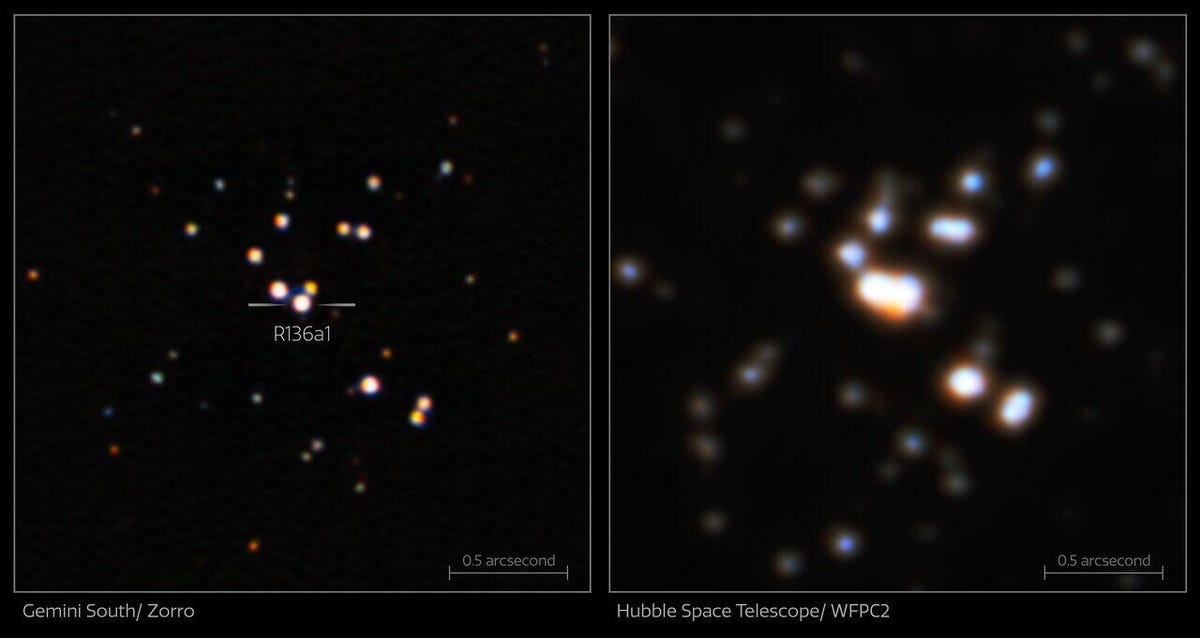
Universe's Most Massive Known Star Imaged With Unprecedented Clarity
To put it simply, the universe's most massive known star is less massive than scientists once believed. But even docked a few levels, this staggering ball of gas is still the universe's most massive known star. That's how utterly huge it is.
Lovingly named R136a1, the luminous giant lives 160,000 light-years from Earth in the center of a stunning, stringy star factory known as the Tarantula Nebula. Last week, astronomers announced that celestial observations collected with the Gemini South Telescope in Chile produced the sharpest image ever taken of it -- thus unveiling its true heft.
For years, data suggested this star held a mass somewhere between 250 to 350 times the sun's. But according to the team's study slated to appear in The Astrophysical Journal, the new view indicates it's more like 170 to 230 times the mass of our host star.
Nevertheless, R136a1 is a gleaming monster.
"Even with this lower estimate, R136a1 still qualifies as the most massive known star," the research team said in a press release.
For context, the Earth has a mass of around (don't think about this number, just feel it) 6,000,000,000,000,000,000,000,000 kilograms. Jupiter's mass is 318 times even that. This all accounts for just two worlds in our cosmic neighborhood. And yet the sun comprises 99.8% of the mass of the entire solar system. If that hurt your brain, another way to think about the size discrepancy is something like a million Earths could fit inside the sun.
So, yeah. R136a1 is between 170 and 230 times more massive than the sun. Do with this information what you will.

An artist's illustration of R136a1, the largest known star in the universe, which resides inside the Tarantula Nebula in the Large Magellanic Cloud. Maybe one day we'll get a clear-enough image of this stellar body to rival even this portrait.
NOIRLab/NSF/AURA/J. da Silva/SpaceengineFor the purpose of scientific advancement, "this suggests that the upper limit on stellar masses may also be smaller than previously thought," Venu M. Kalari, an astronomer at the National Science Foundation's NOIRLab and lead author of the paper, said in the release.
Plus, Kalari's results might implicate our understanding of certain elements in the universe, particularly those created from the explosive deaths of stars with over 150 solar masses -- the ones that went with the biggest of bangs.
Basically, the universe's most spectacular, scorching and humongous stars are also typically its most fleeting, faraway and mysterious ones.
First of all, really massive stellar bodies tend to exist inside densely populated star clusters that are concealed by residual stardust, like R136a1 resides within the Tarantula Nebula. That makes it pretty difficult for terrestrial equipment to discern precise qualities of a colossal star of interest -- other stars kind of interfere with observations.

This image shows how the sharpness and clarity of the Zorro imager on the 8.1-meter Gemini South telescope in Chile (left) compares to to an earlier image of R136a1 taken with the NASA/ESA Hubble Space Telescope (right).
International Gemini Observatory/NOIRLab/NSF/AURA Acknowledgment: Image processing: T.A. Rector (University of Alaska Anchorage/NSF's NOIRLab), M. Zamani (NSF's NOIRLab) & D. de Martin (NSF's NOIRLab); NASA/ESA Hubble Space Telescope"Giant stars also live fast and die young," according to the NOIRLab, an organization that operates the Gemini South Telescope, "burning through their fuel reserves in only a few million years. In comparison, our sun is less than halfway through its 10 billion year lifespan." Aka, there's a bit of a time limit for the already-daunting task of identifying super massive stars within a dust-shrouded star cluster.
Here's where the Gemini South Telescope comes in.
To image R136a1 with unprecedented clarity, this machine used a special instrument called Zorro to get around some (giant) stargazing hurdles. Zorro used a technique known as speckle imaging, which helped the telescope overcome the blurring effect caused by Earth's atmosphere. Atmospheric blurring poses such a big barrier for telescope observations that, in fact, this was the reason NASA launched the Hubble Space Telescope in 1990. At the time, the goal was to get a lens above our planet's atmosphere for beautiful, clear cosmic pictures.
Still on the ground, however, Zorro circumvented the atmospheric blur issue in a different way. It essentially took thousands of short-exposure R136a1 images, which were then digitally processed by the study team.
"Given the right conditions, an 8.1-meter telescope pushed to its limits can rival not only the Hubble Space Telescope when it comes to angular resolution, but also the James Webb Space Telescope," Ricardo Salinas, co-author of the paper and instrument scientist for Zorro, said in the release. "This observation pushes the boundary of what is considered possible using speckle imaging."
The eventual image conglomerate was sharp enough to allow the team to separate R136a1's brightness from luminescence shed by stellar companions in its vicinity, which led to a lower estimate of its brightness, and therefore mass. "Astronomers are able to estimate a star's mass by comparing its observed brightness and temperature with theoretical predictions," according to the NOIRLab.
"We began this work as an exploratory observation to see how well Zorro could observe this type of object," Kalari said. "While we urge caution when interpreting our results, our observations indicate that the most massive stars may not be as massive as once thought."
Source
Tags:
- Universe S Most Massive Known Star Images With Unprecedented Clarity
- Universe S Most Massive Known Star Images With Unprecedented Def
- Universe S Most Massive Known Star Images With Unprecedented Times
- Universe S Most Massive Known Star Imaged Meaning
- Universe S Most Massive Known Star
- Universe S Most Massive Dwarf
- Universe S Most Massive Subatomic Particle
- Universe S Most Wanted
- Universe S Most Jealous Goddess Ch 17
Blog Archive
-
▼
2023
(199)
-
▼
January
(84)
- Logan Paul Has Just Signed With The WWE
- Heat Pump Vs. Furnace: Learn The Difference Betwee...
- Soon You'll Be Able To Book Office Spaces Through ...
- How To Fix 5 Common Causes For Your Home Internet ...
- Polar Pro Venture3+ Lens, Filter Pack Helps You Ge...
- Find Out What's Coming In The Mail Before It's Del...
- This 43-Inch Amazon Fire TV Is Down To Its Lowest ...
- Save Up To $250 On A Premium Samsung Tablet Today ...
- Wordle: What To Know About The Viral Word Game
- Gaming Monitors From CES 2022 To Get Hyped For
- 2023 Honda CR-V Teased Ahead Of Summer Debut
- James Webb Space Telescope's Smooth Launch Extende...
- Save Big On Motorola Phones With Prices Starting A...
- Ouya Teams With Xiaomi To Bring Video Games To China
- The Best Cat Toys, According To Our Favorite Felines
- Nvidia To Buy SoftBank's Arm Chip Division For $40...
- 5 Great Last-minute Gifts To Make With Your 3D Pri...
- GM Announces Plans For National EV Fast Charging N...
- 2022 Kia Sorento Receives Price Hikes Across The B...
- T-Mobile Is Offering Unlimited Google Photos Storage
- Amazon To Acquire One Medical In Major Boost To It...
- Lenovo Glasses T1 Are Wearable Displays That Also ...
- 'MythBusters' Adam Savage Tests DJI Inspire 1 4K Q...
- Best Home Security Deals For Black Friday: Save On...
- TikTok Live To Feature Hour-Long Sketch Comedy Sho...
- Air Frying Vs. Baking: What's The Best Cooking Met...
- Crocheted Predator Costume Goes On The Hunt For Ha...
- Acer Goes After The Classroom With New Durable Spi...
- Google Store Stumbles During Pixel 6 Phone Launch
- WhatsApp Will Let You Move Chat History Between IO...
- Monitor OS X LaunchAgents Folders To Help Prevent ...
- Motorola Edge Plus 2022 Vs. 2020: It's Not An Easy...
- GoPro, Red Bull Partner To Capture The World Of Ex...
- Facebook's $37.5 Million Location Tracking Settlem...
- Apple Rumored To Be Working On A Foldable IPad/Mac...
- Asus ROG Phone 6, 6 Pro Gaming Phones Bring Samsun...
- Nintendo Of America Testers Allege Sexual Harassme...
- Kia EV9 Electric Concept Previews A 3-row Producti...
- These Stunning Pens Bring Back The Joy Of Writing
- 7 Ways To Save Money On Car Insurance
- Best Immersion Blender For 2022
- The IPhone At 15: How Apple's Phone Became The Cen...
- TikTok's China Equivalent Limits Kids To 40 Minute...
- You Can Now Play Wordle On NYT Crossword App
- How To Remove Wallpaper In An Old Or Period House
- 60 Super-cool Kitchen Gadgets You Can Get For Less...
- Apple's 16-inch MacBook Pro Gets Graphics Boost Wi...
- MLB TV Review: Subscribers May Balk At Increased B...
- Monkeypox Outbreak: Symptoms, Variants And Trends ...
- Samsung Galaxy S22 Ultra Vs. Pixel 6 Pro: It's A T...
- Asus ZenBook Duo 14 UX482 Review: A Dual-screen La...
- Leaked Pics Of Huawei's Updated Freebuds Show Wire...
- Samsung QN90B QLED Vs. LG C2 OLED: Which TV Is Bes...
- Don't Swap Your Gas-Guzzler For An Electric Vehicl...
- 6 Important Things To Know About Your Social Secur...
- Universe's Most Massive Known Star Imaged With Unp...
- Xiaomi Mi Smart Projector 2: High Style, Low Brigh...
- Asus ZenBook 13 UX333 Review: New Asus ZenBooks Pa...
- WWE Hell In A Cell 2020: Results, Full Recap And N...
- Red Alert! New Honda Civic Type R Coming Next Year...
- Meta Has A Giant New AI Supercomputer To Shape The...
- 2022 Kia EV6 Review: Best Foot Forward
- Shop Coach Outlet's Varsity Collection With Prices...
- Pixar's 'Turning Red' Teams Up With Firefox To Cel...
- Shopping At Wayfair? These 3 Simple Tips Will Make...
- Facebook Is Growing Its Daily Users Again
- Moto G Fast Vs. G Power Vs. G Stylus: Motorola Bud...
- WWE Elimination Chamber 2022: Start Times, Full Ca...
- The IPhone SE, Not The Mini, May Be The Future Of ...
- RedMagic 7S Pro's Highlight Feature May Be Its Hid...
- 2021 Honda Accord Reveal: Fresh Style, More Tech B...
- Motorola Edge Plus Hands-on: A $1,000 5G Phone Wit...
- Best High-Tech Ski Gear For 2022
- Google In Hot Water For Sending Unwanted Ad Emails
- Hisense Recalls French-Door Fridge Due To Injury R...
- The App That Helps Prepare You For Death
- Your MacBook Trackpad Has An Annoying Setting You ...
- Acer Chromebook R11 Review: A Finger-friendly Hybr...
- The IPhone At 15: Steve Jobs Revealed His Greatest...
- Universe's Most Massive Known Star Imaged With Unp...
- Bored Kids? Get Them This Indoor Beginner Drone Fo...
- Thirsty Suitors: Battle Your Exes In This Colorful...
- HP's New Spectre Laptops Have A Webcam Kill Switch...
- Are USDA Loans Available To Everyone? How To Know ...
-
▼
January
(84)
Total Pageviews
Search This Blog
Popular Posts
-
Contoh soalan fizik spm 2019, contoh soalan fizik spm 2018, contoh soalan fizik spm 2017, contoh soalan fizik kertas 3, contoh soalan fizik ...
-
Ukuran sepatu, ukuran sepatu us, ukuran sepatu anak, ukuran sepatu eu, ukuran sepatu eur, ukuran sepatu nike, ukuran sepatu adidas, ukuran s...
-
Ukuran tv, ukuran tv 32 inch, ukuran tv 40 inch, ukuran tv 42 inch, ukuran tv 60 inch, ukuran tv 42, ukuran tv lcd, ukuran tv led, ukuran tv...
